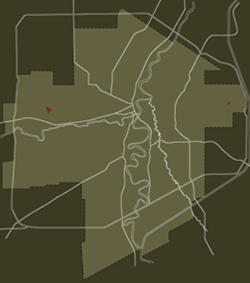Urbanization And The Landscape

Winnipeg – circa 1980
Urbanization had a major role in altering the native prairie landscape. As towns and cities continued to expand into rural land, introduced plants and weed species from city lots were spread into any remaining native grasslands.
From the late 1960’s to the 1980’s, remnants of Tall Grass Prairie all over Manitoba were identified and protected from further decimation. In Manitoba sixty-four Tall Grass Prairie remnants examined in 1968 by the International Biological Program. In Winnipeg, two major sites were acknowledged: the Bradley Prairie in an industrial area northeast of downtown, and the 32 acre, (12.95 h.) Living Prairie Museum located west of downtown (shown on map in red).
The Living Prairie Museum site was found to be the best example of Tall Grass Prairie in the province. City naturalists fought to stop the planned development of the area and save the remnant. In the early 1970’s the land was set aside and an Interpretive Centre built. The creation of this museum played a major role in educating the public about the loss of this important ecosystem.